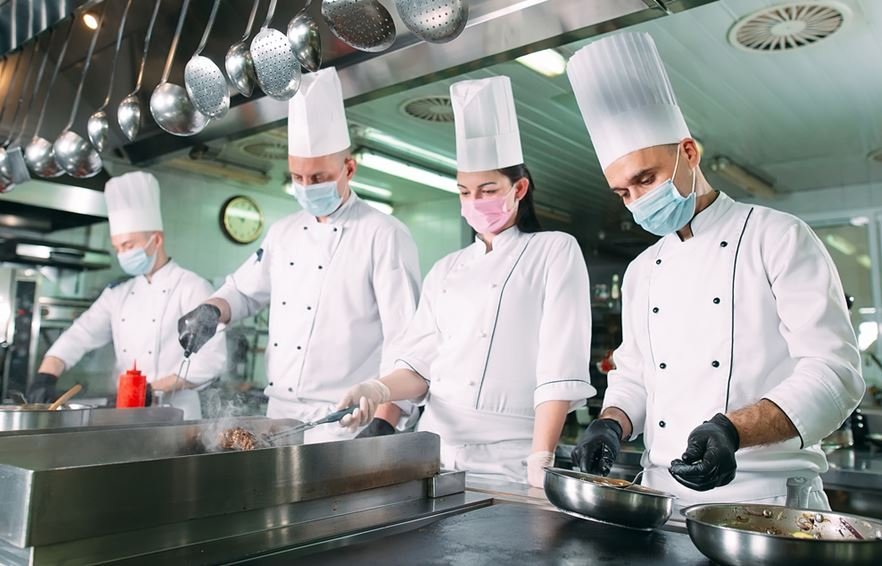Kitchen
Kitchen Safety – Tips and Precautions

A daily mail report in 2012 claimed that Brits spend 3 years of their life on average in the kitchen. And that’s not particularly surprising. Our love affair with food is a special one. So, despite restaurants’ takeaway and delivery services, a significant part of our day is spent rustling up for favourite recipes in the kitchen.
However, it’s a fact that in most houses, the kitchen is also the most neglected area even if it requires most of your attention in terms of safety and precautions.
As they say, the kitchen is the heart of your home – everyone in the home uses it and it’s probably where the most memorable memories are. But many people tend to forget that the kitchen can also be surprisingly dangerous if you don’t take proper precautionary and safety measures.
Since the kitchen is loaded with sharp equipment, gas tools, hot surfaces, and boiling water, it’s no surprise 60% of people have been injured in their kitchen once in a lifetime. This is usually due to people not taking essential precautionary measures surrounding their kitchens.
So, oftentimes, even if you’re aware of the dangers surrounding you, it’s highly likely you’re not doing much to limit them. In this article, we’ll be discussing several ways for you to make your kitchen a safe haven for you and your family. So, if you’re interested in fascinating safety and precautionary tips, keep reading!
[lwptoc]
-
Ensure Gas Safety
Many kitchens possess gas appliances, such as ovens, grills, and stoves. If these appliances are properly maintained and regularly inspected, oftentimes they do not pose a threat.
However, non-maintenance can lead to them releasing carbon monoxide – an odourless and poisonous gas that can have dangerous consequences for your house. Nevertheless, if you take precautionary measures, you can prevent any hazard from taking place.
This can be done in several ways:
- If you’re a homeowner or landlord in the UK, it’s mandatory by law to obtain a gas safety certificate that costs around£60 by having a gas safe register engineer inspect all the gas appliances at your home. This will limit any safety hazards and also keep you on the right side of the law.
- Install carbon detectors. Since regular smoke detectors aren’t eligible to detect carbon monoxide, this can go a long way in ensuring the safety of your kitchen.
- This may come as a surprise to some, but burnt food can release carbon monoxide. So, it’s essential to always clean your gas hobs.
- If you have a gas boiler in your kitchen, regularly lookout for debris and other blockages in its vents.
- If the fire seems to be getting out of your control, call 999 immediately for help.
-
Install a Fire Extinguisher
Most people do not consider it important to install a fire extinguisher in their kitchen even when it should be the most important gadget to have in the kitchen. An accident should always be expected even though the idea of them may not seem possible. Therefore, it’s essential for you and your family’s safety to install a fire extinguisher in your kitchen.
Moreover, make sure you install it in a place where it’s easily accessible and teach everyone in the house to use it.
-
Understand What to Do In case of An Accident
No one plans for a safety hazard such as a fire to occur in their kitchen, accidents tend to happen without warning. Therefore, it’s important to educate yourself and those around you regarding what can be done in case of a fire. Know that oxygen tends to aggravate most fires.
So, it’s best to try to put out a fire in your kitchen with a pot cover or wet schmatte. If you’re faced with a grease fire, use a metal lid and turn off the heat source immediately. If that fails to work and the fire seems manageable, try smothering it out with baking soda or salt.
However, if the fire gets worse, as a last resort, use a Class B fire extinguisher. And make sure you do not try to extinguish the fire with water.
Related Post: Improve Your Kitchen Energy Efficiency with a Gas Cook Top
-
Be Wary of Clothing and Other Accessories
Yes, that’s correct! It’s impossible for clothing and accessories such as bracelets to get you into a safety hazard. Sometimes, bracelets can get stock on pot handles whereas the loose bell sleeves on your favorite top may catch fire. So, it’s essential to be cautious about what you wear while cooking and always make sure to turn pot handles in so they aren’t grabbed by kids.
-
Use Your Knives Safely
Knives are undoubtedly one of the most dangerous kitchen utensils, which is why it’s essential to be extra careful with them. Firstly, always make sure you store the knives in your kitchen in cabinets, or wherever they may inaccessible for kids. However, that’s not all. Even though there are specific safety classes cantered around using knives safely, we’ve combined a list of the most important precautions you could practice:
- Whenever you’re using a knife for food cutting, make sure you cut towards the cutting board rather than your body.
- Make sure your cutting board does not move too much. Although, if it does, put a damp cloth between the counter and the table.
- Adhere from putting a knife in a sink full of dishes. As that could lead to someone getting hurt while cleaning dishes.
- Keep your knife handles free of grease or other slippery substances as that can get cause them to slip and hurt someone.
-
Be Cautious About Food Burns
Everyone likes their food warm. However, many kitchen accidents are caused by food burns from hot food. Here’s how you can prevent yourself from getting food burns:
- Always use a potholder while removing tops from cooking food to stay safe from a steam burn.
- When near hot oil, always be wary of liquids as they can cause the oil to splatter and cause burns.
- If you’re blending hot food, try to maintain a distance from the blender as they are likely to explode and cause injury.
- Make sure to turn pot and panhandles in towards the stove or counter as someone passing by does not notice they’re hot and get hurt.
-
Clean Up Spilled Food
Spills lead to slips and slips lead to injuries. Most of the time we’re so mesmerized by a warm meal that we prefer to clean up ingredients or food spilled on the kitchen floor after we’re done with our meals. But that can surprisingly dangerous especially in a home with children. So, make sure to clean up on time to prevent serious injuries.
-
Keep Pets and Children Out of Reach
Make sure your kitchen a ”no pet” and ”no toy” zone! Children and pets often have a habit of lurking around in the kitchen but often, that can be extremely dangerous. From oil splatters to spilled food, all these things present a safety hazard.
Even when you’ve wrapped up your meal, appliances and utensils such as pots, pans, a toaster oven, and a baking oven can stay hot for a long time. So, keep children and pests at bay in your kitchen. And be extra cautious about leaving them unattended at all times.
-
Be Watchful of Water
This is another precaution many people neglect. Whenever you’re in the kitchen, be vigilant about getting anywhere near electric appliances. And also make sure to keep your hands away from electrical sockets particularly if they’re wet. This prevents electric shocks. Moreover, make sure to teach your children to never put their hands near electrical sockets.
-
Sanitize Your Kitchen Regularly
Believe it or not, bacteria thrive in your kitchen probably more than in any other area in your house. To keep the germs and bacteria away, it’s essential to sanitize your kitchen on a daily basis. All the safety regulations and laws need to be taught to the staff through food handler safety training when they’re hired.
You can start purchasing sanitizers designed especially for kitchen use and clean the cutting board and cabinets with them thoroughly. If you do not have a sanitizer for kitchen use, use a homemade bleach and water solution.
Moreover, always keep your dishwashing sponges clean as they tend to house bacteria. You can do this by wetting the sponge and keeping it in the microwave for a minute and a half. Another way you can keep your kitchen clean is by washing the kitchen rags in hot water every day or two.
Safety Measures and Maintenance for the Kitchen
Like every other room in your house, your kitchen requires equal attention from you to keep it safe and secure for use. Failure to maintain your appliances can result in an increased threat of hazards such as carbon monoxide build up, gas leakage, and fires.
Moreover, you should take care when handling sharp objects like knives and kitchen gadgets to avoid any accidents. Keep them out of reach of children and always handle them carefully. We hope our safety and precautionary tips will help keep safety hazards at bay.
Related Post: How to Keep Your Kitchen Stainless Steel Appliances Going and Glowing













